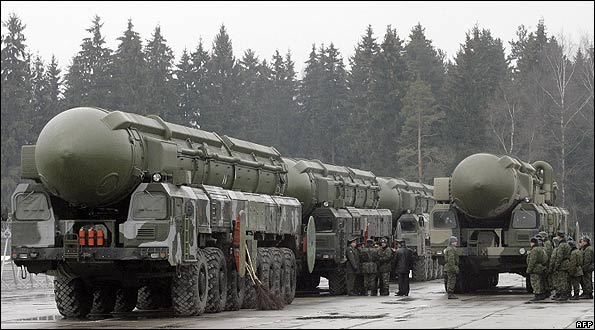
From George Shultz, William Perry, Henry Kissinger and Sam Nunn, the Wall Street Journal: The doctrine of mutual assured destruction is obsolete in the post-Cold War era.
Recently, the four of us met at the Hoover Institution with a group of policy experts to discuss the possibilities for establishing a safer and more comprehensive form of deterrence and prevention in a world where the roles and risks of nuclear weapons are reduced and ultimately eliminated. Our broad conclusion is that nations should move forward together with a series of conceptual and practical steps toward deterrence that do not rely primarily on nuclear weapons or nuclear threats to maintain international peace and security.
The first step is to recognize that there is a daunting new spectrum of global security threats. These threats include chemical, biological and radiological weapons, catastrophic terrorism and cyber warfare, as well as natural disasters resulting from climate change or other environmental problems, and health-related crises. For the United States and many other nations, existential threats relating to the very survival of the state have diminished, largely because of the end of the Cold War and the increasing realization that our common interests greatly exceed our differences. However, an accident or mistake involving nuclear weapons, or nuclear terrorism fueled by the spread of nuclear weapons, nuclear materials, and nuclear know-how, is still a very real risk. An effective strategy to deal with these dangers must be developed.
The second step is the realization that continued reliance on nuclear weapons as the principal element for deterrence is encouraging, or at least excusing, the spread of these weapons, and will inevitably erode the essential cooperation necessary to avoid proliferation, protect nuclear materials and deal effectively with new threats.
Third, the U.S. and Russia have no basis for maintaining a structure of deterrence involving nuclear weapons deployed in ways that increase the danger of an accidental or unauthorized use of a nuclear weapon, or even a deliberate nuclear exchange based on a false warning. Reducing the number of operationally deployed strategic nuclear warheads and delivery vehicles with verification to the levels set by the New Start Treaty is an important step in reducing nuclear risks. Deeper nuclear reductions and changes in nuclear force posture involving the two nations should remain a priority. Further steps must include short-range tactical nuclear weapons.
Fourth, as long as nuclear weapons exist, America must retain a safe, secure and reliable nuclear stockpile primarily to deter a nuclear attack and to reassure our allies through extended deterrence. There is an inherent limit to U.S. and Russian nuclear reductions if other nuclear weapon states build up their inventories or if new nuclear powers emerge.
It is clear, however, that the U.S. and Russia—having led the nuclear buildup for decades—must continue to lead the build-down. The U.S. and its NATO allies, together with Russia, must begin moving away from threatening force postures and deployments including the retention of thousands of short-range battlefield nuclear weapons. All conventional deployments should be reviewed from the aspect of provocation. This will make America, Russia and Europe more secure. It will also set an example for the world.
Mr. Shultz was secretary of state from 1982 to 1989. Mr. Perry was secretary of defense from 1994 to 1997. Mr. Kissinger was secretary of state from 1973 to 1977. Mr. Nunn is former chairman of the Senate Armed Services Committee. (photo: AFP)
Image: afp%2011%2030%2010%20Russian%20nuclear%20weapons.jpg
